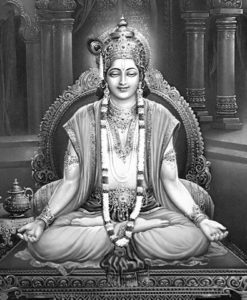The word ‘yoga’ has several meanings. In the Bhagavad-Gītā (2.48,50; 5.1,5,7), yoga is used in the sense of karma (activity) or karma-yoga (activity without selfish motives, work without expectations). Yoga is also used synonymously with indriya-nigraha (control of sense organs and the organs of activity) (Kaṭhopaniṣad 6.11), cittaikāgrata (mental concentration, focus) (Yoga-sūtra 1.1, adhyāya 6 of Bhagavad-Gītā), prakaraṇa (chapter), vidhāna (means), and mārga (path).
The discipline of yoga is not an easy one; because, it primarily demands a mastery over the senses and the mind. To gain this mastery, it needs constant practice and detachment (Bhagavad-gītā 6.35, Yoga-sūtra 1.12). The procedure for this is also elaborated in an easy manner in the Kaṭhopaniṣad (3.13). This control over mind and body is needed since they can’t perceive the pratyagātma (the ātma within) without such control. Just like a man cannot see his own back, without such mastery, one cannot perceive one’s own ātma. The senses and the mind are like the horses yoked to a chariot. To bring them under control, one needs fortitude and wisdom (Kaṭhopaniṣad 4.1, 3.5-6). Due to the
wavering nature of the senses and the mind, the citta is always disturbed and is in the state of vṛtti (citta-vṛttis are the activities of the internal landscape, i.e., the mind and the intellect, roughly put). When the citta-vṛtti is brought under control, the drasṭṛ, the substratum, i.e., as an Absolute Witness (sākṣi-puruṣa), attains his true state (sva-svarūpa). This silencing of citta-vṛtti is yoga (Yoga-sūtra 1.2-3). Just like the sunlight that falls on a convex lens converges to a point, citta-vṛtti that is brought under control through constant practise reaches yoga of single-pointed focus. All the practises described in the yoga-śāstra are meant to bring the vṛttis under control to attain the nirbīja-samādhi, thus leading to the experience of the Absolute. (Yoga-sūtra 1.51). The attainment of siddhis and vibhūtis as by-products is not important. As the mind and the prāṇa (breath) are inseparable from the body, to bring the body and the breath under control, the practise of āsana and prāṇayāma is prescribed. These form the core of haṭha-yoga; however, these are not very important. Although physical health is essential, mere movement of the limbs and holding of the breath do not suffice to silence the citta. Meditating upon the īśvara is important; in fact that alone is sufficient. (“ईश्वरप्रणिधानाद्वा” – Yoga-sūtra 1.23). If one has found fructification through dhyāna, everything else comes on its own accord. The last four limbs of yoga, i.e., pratyāhāra, dhāraṇa, dhyāna, and samādhi are the four steps of dhyāna-siddhi. The preceding limbs - āsana and prāṇayāma are the means of bringing the body and breath under control. Yama and niyama, the first two limbs of yoga are the preliminary stages. In a sense, these are more important than anything else. The reason being that they are essential for physical well-being, control of senses and equilibrium of the citta. Ahiṃsā (non-violence), Satya (Honesty), Asteya (not stealing), Brahmacarya (adhering to the brahman, a disciplined life) and Aparigraha (not coveting others’ wealth, non-avarice) constitute yama (the 'don'ts') . Śauca (physical and mental purity), Santoṣa (contentment), Tapas (intense meditation, self-discipline), Svādhyāya (self-study, introspection), Īśvarapraṇidhāna (surrender to the Supreme) constitute niyama (the dos). These need to be practised by people at all times, from all places (Yoga-sutra 2.3-3.2 says “एते जाति-देश-काल-समयानवच्छिन्नाः सार्वभौममहाव्रतम्।”) All these can be put together under one head, śīla (character). The Mahābhārata speaks of this at several places and reiterates it in different ways. It is from śīla (i.e. good character) that dharma, satya, conduct, strength, and wealth are obtained. Therefore, a person with bad character cannot progress on the path of yoga.
Ancient and modern philosophers condemn Sāṅkhya. Vedānta treats Sāṅkhya as its pūrva-pakṣa (arguments of the opponent that need to be countered). However, seen from a different perspective, Sāṅkhya can be considered to have laid the path for Vedānta, if we deem the prakṛti (of Sāṅkhya) as māyā (of Vedānta), puruṣa as brahman, liṅga-śarīra as jīvātmā, and īśvara as paramātma [Cf. Śvetāśvataropaniṣad and Vedāntasāra of Sadānanda]. One can, however, identify the shortcomings in the nyāyas (analogies) used in Sāṅkhya such as andha-paṅgu-nyāya (blind and lame companionship), tapta-loha-nyāya (conduction in heated iron), and prekṣaka-nartakī-nyāya (spectator and dancer relation). But all analogies and similes are indeed incomplete. While they help give a semblance of the original, they cannot give an experience of the actual concept, for they are mere reflections. Moreover, it is easy to criticize things we can’t grasp by direct perception. Also, it might be far removed from universal experience. Sāṅkhya was, after all, born out of the speculation of philosophers and not through direct experience. For statements such as “अजामेकां लोहित-शुक्ल-कृष्णां” the basis was the observation of male and female goats by those early philosophers. If not, who had seen the birth of the universe? Thus, in essence, we can say that it is merely anumāna (inference) of the thinkers of the past.
Today we have the world before us; what comes under the purview of absolute experience is the ‘I’-ness (sense of the self). Philosophers say that once this ‘self’ is understood, everything else is understood, for the caitanya (substratum, illuminator of knowledge) of the universe is the same as the caitanya of the individual. To realize this one needs to practice dhyāna and yoga.
A sizeable portion of the Bhagavad-gītā is devoted to this Sāṅkhya-Yoga and its related aspects. Here, ‘yoga’ has two meanings: anāsakti-yoga, the path of detachment (i.e., karma-yoga) and rāja-yoga; adhyāyas 16 and 17 of the Bhagavad-gītā speak about transforming the traits of rajas and tamas in an individual to that of sattva by means of yajña-dāna-tapas-āhara-vihāra. These practices subdue the baser tendencies and awaken the individual to sattva, which in turn leads to daivī-sampat (divine qualities) and therefore to Absolute knowledge. Adhyāya 6 says that one must bring the mind under control through constant practice and an attitude of detachment. There are also subtle references to bhakti and the ritualistic aspects. But they come in reference to Sāṅkhya and Yoga (See Bhagavad-Gītā 4.25-33; 9.8,10,12; 3.6,15-17). Kṛṣṇa is a brilliant mind; by his charisma, the Vaiṣṇava-dharma grew into prominence. But he has never forced anybody to worship him. When the Bhagavad-gītā was documented by the poet, Kṛṣṇa was not alive; even during Kṛṣṇa’s time, not everyone considered him to be an avatāra (incarnation) or as the Supreme being. So what? Whatever he has spoken in the Bhagavad-gītā, he has shown in action in his own life, which can be seen throughout in the epic. India and the Mahābhārata are both filled with Kṛṣṇa -dharma (the vision of Kṛṣṇa). The Bhagavad-gītā is after all, a summary of the words and actions of Kṛṣṇa as well as other great characters of the epic. He is yogeśvara (master of yoga); he applied his brilliance and experience during the peace mission as well as during the war-time counsel he gave Arjuna (i.e., the gitopadeśa). Finally he gave up his body through the path of yoga. Bhīṣma, Droṇa, Balarāma, Vasudeva – all gave up their bodies similarly through yoga. Kālidāsa also says a similar thing while referring to all the kings of the Ikṣvāku-vaṃśa (“योगेनान्ते तनुत्यजाम्” – Raghuvaṃśa 1.8). All of these great men probably were regular practitioners of yoga and had acquired mastery over it.
[Note: Anu-gītā is merely a shadow of the Bhagavad-gītā. Arjuna had forgotten the advice that he had received on the battlefield; Krishna too had forgotten the exact words that he spoke. So instead he narrated to Arjuna the words spoken by some philosopher in the past to someone else. This is the Anu-gītā!
Translator's Note: Kṛṣṇa would have preached Bhagavad-gītā to Arjuna on the battle-field. He, however, might not have said it in the form of verses. The seven hundred metrical verses of the gītā were composed by the author of the epic, Vyāsa, based on the philosophy that Kṛṣṇa spoke in the battle-field]



















































